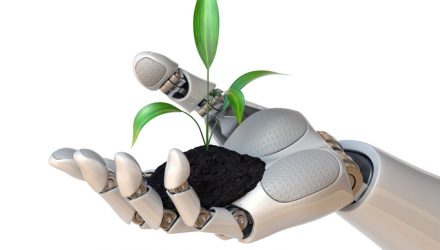To provide some perspective into the types of companies that are added and why, here’s a quick look at just three of the year’s additions to the index:
- Biotelemetry was added to the ROBO index in 4Q18 to benefit from its leadership role in mobile cardiac monitoring. Biotelemetry holds an impressive 60%+ market share in mobile cardiac outpatient telemetry (MCOT) and is quickly gaining traction in extended-wear Holters—despite entering the product category just over a year ago. Revenue for the line is expected to double in the next two to three years. A 2017 acquisition of Lifewatch for $280M further strengthened Biotelemetry’s market positioning, contributing to sales of ~$400M in 2018. Excluding acquisitions, sales growth is expected to be around 10-15%.
- Illumina was added to the ROBO index in 3Q18 in response to the company’s success in lab automaton, reducing the time and cost of human genome sequencing—one of the most important breakthroughs in the high-performing healthcare industry. Less than a decade ago, sequencing one human genome cost $10M and took several months of computing power to complete. Today, the cost is approximately $1,000 and requires less than a day. Within a few years, the process is expected to drop to $100 and take just minutes. Illumina is one of the companies that is making that progress possible. Thanks to breakthroughs associated with Illumina’s Hi-Seq X-10, capacity is now in place to sequence 684,000 human genomes in a single year. Its recently announced acquisition of Pacific Biosciences is expected to accelerate progress and revenues at an even faster pace.
- Ocado was added to the ROBO index in 2Q18 after the British online grocer and market leader announced a partnership with US-based Kroger, who will invest $9B in the construction of robotically operated warehouses. Kroger’s goal? To compete effectively with industry disruptor Amazon. Just four months after the partnership was announced, Kroger announced impressive progress in identifying possible locations for the first of 20+ sites for planned automated warehouses across the US. The Kroger partnership is the biggest yet for Ocado, which has similar projects in place with grocery retailers in Britain, France, Canada, and Sweden.
Concentration on fast-growing sectors adds strength in times of weakness
RAAI technologies have advanced dramatically over the past five years, leapfrogging past innovations to create almost unimaginable breakthroughs in capabilities and applications. Industry disruption has become the new normal as companies who fail to adapt their technologies and business models fall—and those who do adapt rise. And this level of change and growth is happening in every industry and every region of the world.
Healthcare leads the pack, not only in RAAI-focused investments and revenue growth but in tangible results that are visible to investors. Progress in genome sequencing is changing how we diagnose and treat disease. Robot-assisted surgeries are improving patient outcomes and reducing healthcare costs. Exoskeletons are improving patient mobility and helping caregivers lift patients to provide better care. In food and agriculture, robots are feeding, watering, and picking crops to increase output from limited resources. In logistics, AI and automation are accelerating supply chains and dramatically increasing speed-to-delivery. In manufacturing, cobots are increasing factory efficiency and decreasing costs. And in every one of these industries, failure to adopt means failure to compete. RAAI has become a must-have for companies that hope to thrive in the future.
Diversification of subsectors and market caps offers unique exposure
Invested entirely in companies that are leaders or emerging leaders in RAAI, the ROBO Global Robotics & Automation Index uses a rigorous Industry Classification process that is designed to provide multiple levels of diversification. Starting with a universe of more than 1,000 global innovators, we narrow that down to include only those companies that fit into 1 of the 12 subsectors we’ve identified as growth leaders, that meet our requirements for robotics and automation revenue, and that adhere to our ESG policy. We then turn to the research and insights of our Strategic Advisory Board—including a team of 9 PhDs, professors, and researchers who are each recognized experts in their fields—to evaluate the technology and market leadership of each company.
The result is a mix of 80 or more companies that span the entire RAAI supply chain. Of those companies, more than half are mid-caps, with the remaining members split between small-cap and large-cap companies. This is a major contrast to some newer indexes that attempt to target the RAAI opportunity by allocating a high % to only the best-known, largest-cap players in the space. ROBO offers less than 2% overlap with the larger indexes like the S&P 500 and ACWI All World.
In today’s volatile market environment, the advisor’s job is to keep clients from abandoning their plans due to fear. No growth strategy is entirely free of risk and there is no silver bullet. But for advisors who understand the balance between risk and reward and who are seeking a way to use lower prices and higher market volatility to their advantage, the ROBO Global Robotics & Automation Index may be the ideal solution. And telling the ROBO story may just be the key to helping you succeed in keeping your clients invested and on track toward their long-term financial goals.
For more news on robotics, AI and more, visit the Robotics & AI Channel.
